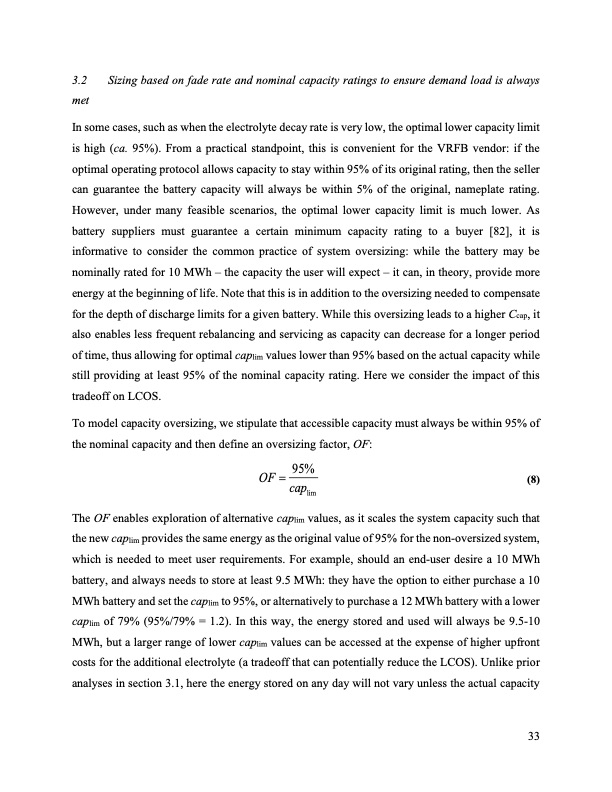
PDF Publication Title:
Text from PDF Page: 033
3.2 Sizing based on fade rate and nominal capacity ratings to ensure demand load is always met In some cases, such as when the electrolyte decay rate is very low, the optimal lower capacity limit is high (ca. 95%). From a practical standpoint, this is convenient for the VRFB vendor: if the optimal operating protocol allows capacity to stay within 95% of its original rating, then the seller can guarantee the battery capacity will always be within 5% of the original, nameplate rating. However, under many feasible scenarios, the optimal lower capacity limit is much lower. As battery suppliers must guarantee a certain minimum capacity rating to a buyer [82], it is informative to consider the common practice of system oversizing: while the battery may be nominally rated for 10 MWh – the capacity the user will expect – it can, in theory, provide more energy at the beginning of life. Note that this is in addition to the oversizing needed to compensate for the depth of discharge limits for a given battery. While this oversizing leads to a higher Ccap, it also enables less frequent rebalancing and servicing as capacity can decrease for a longer period of time, thus allowing for optimal caplim values lower than 95% based on the actual capacity while still providing at least 95% of the nominal capacity rating. Here we consider the impact of this tradeoff on LCOS. To model capacity oversizing, we stipulate that accessible capacity must always be within 95% of the nominal capacity and then define an oversizing factor, OF: OF = 95% caplim (8) The OF enables exploration of alternative caplim values, as it scales the system capacity such that the new caplim provides the same energy as the original value of 95% for the non-oversized system, which is needed to meet user requirements. For example, should an end-user desire a 10 MWh battery, and always needs to store at least 9.5 MWh: they have the option to either purchase a 10 MWh battery and set the caplim to 95%, or alternatively to purchase a 12 MWh battery with a lower caplim of 79% (95%/79% = 1.2). In this way, the energy stored and used will always be 9.5-10 MWh, but a larger range of lower caplim values can be accessed at the expense of higher upfront costs for the additional electrolyte (a tradeoff that can potentially reduce the LCOS). Unlike prior analyses in section 3.1, here the energy stored on any day will not vary unless the actual capacity 33PDF Image | Bringing Redox Flow Batteries to the Grid

PDF Search Title:
Bringing Redox Flow Batteries to the GridOriginal File Name Searched:
Rodby-krodby-phd-chemE-2022-thesis.pdfDIY PDF Search: Google It | Yahoo | Bing
Salgenx Redox Flow Battery Technology: Salt water flow battery technology with low cost and great energy density that can be used for power storage and thermal storage. Let us de-risk your production using our license. Our aqueous flow battery is less cost than Tesla Megapack and available faster. Redox flow battery. No membrane needed like with Vanadium, or Bromine. Salgenx flow battery
| CONTACT TEL: 608-238-6001 Email: greg@salgenx.com | RSS | AMP |